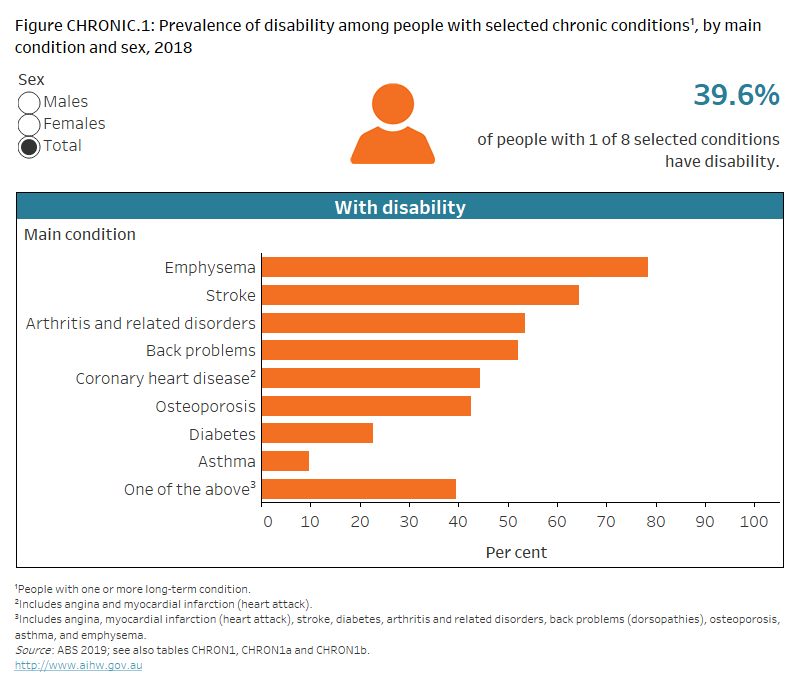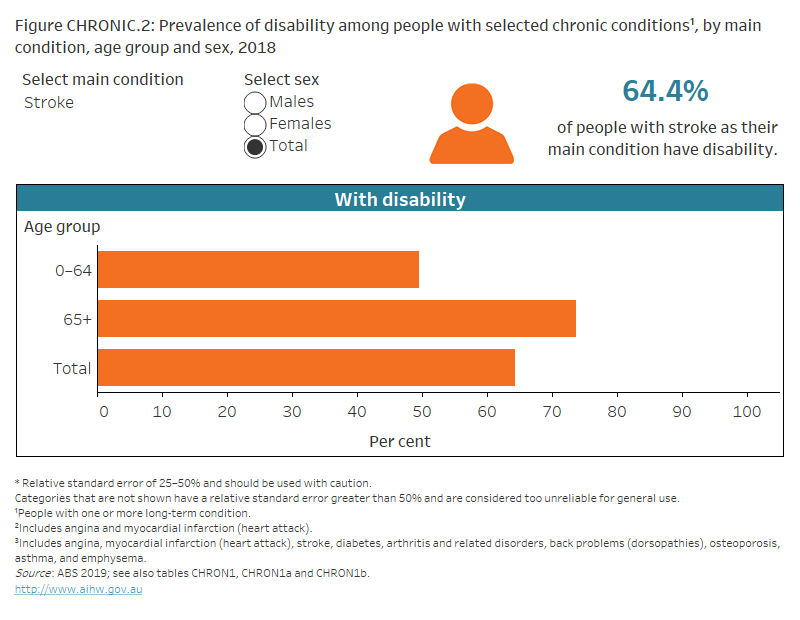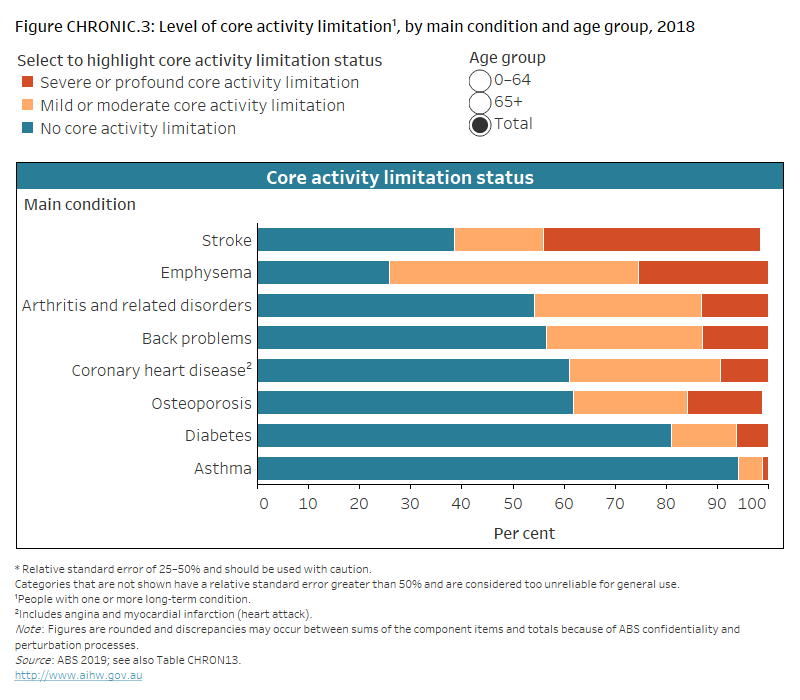Chronic conditions and disability
50% of people
(2.8 million) with one or more of 8 selected chronic conditions also have disability
9.8% of people
with asthma as their main condition have disability
64% of people
with stroke as their main condition have disability
On this page:
Introduction
Chronic health conditions are often associated with some level of disability. This section explores how many people with one or more of 8 selected chronic conditions have disability, and how severe this disability is.
Chronic conditions considered are:
- coronary heart disease
- stroke
- diabetes
- arthritis and related disorders
- back pain and problems
- osteoporosis
- asthma
- emphysema.
These chronic conditions were selected because they are common, pose significant health problems, have been the focus of recent AIHW surveillance projects and, in many instances, action can be taken to prevent their occurrence. See chronic disease for more information.
What are chronic conditions?
Chronic conditions are generally characterised by their long-lasting and persistent effects. They are not usually immediately life threatening but are a common cause of premature death (AHMAC 2017). They have complex and multiple causes, usually come on gradually, and become more common with age. Chronic conditions are often associated with reduced quality of life and limitations in daily living.
Chronic health conditions are the leading cause of illness, disability and death in Australia. About 5.5 million people in Australia are affected by at least one of the 8 chronic health conditions covered in this section. For most (3.7 million), the condition is reported as their main health condition (the condition causing them the most problems) (ABS 2019).
Chronic conditions often coexist with some form of disability:
- half (50% or 2.8 million) of people with at least one selected chronic condition also have disability
- 40% (or 1.5 million) of people who have one selected chronic condition as their main condition also have disability (ABS 2019).
It cannot be assumed that disability is a consequence of a chronic health condition. As such, this section describes only the associations between disability and the selected chronic conditions and does not describe a causal relationship.
What is the relationship between health conditions and disability?
There is a 2-way relationship between health conditions and disability. People with a health condition are more likely to develop disability, and people with disability are more likely to develop a health condition.
Not everyone with a health condition will develop disability, and people with the same health condition who have disability may also experience different forms and level of disability. See Defining disability for more information on the relationship between health conditions and disability.
Survey of Disability, Ageing and Carers
Data in this section are sourced from the Australian Bureau of Statistics’ (ABS) 2018 Survey of Disability, Ageing and Carers (SDAC). The SDAC is the most detailed and comprehensive source of data on disability prevalence in Australia.
The SDAC considers that a person has disability if they have at least one of a list of limitations, restrictions or impairments, which has lasted, or is likely to last, for at least 6 months and restricts everyday activities.
The limitations are grouped into 10 activities associated with daily living – self-care, mobility, communication, cognitive or emotional tasks, health care, reading or writing tasks, transport, household chores, property maintenance, and meal preparation. The SDAC also identifies 2 other life areas in which people may experience restriction or difficulty as a result of disability – schooling and employment.
The severity of disability is defined by whether a person needs help, has difficulty, or uses aids or equipment with 3 core activities – self-care, mobility, and communication – and is grouped for mild, moderate, severe, and profound limitation. People who always or sometimes need help with one or more core activities, have difficulty understanding or being understood by family or friends, or can communicate more easily using sign language or other non-spoken forms of communication are referred to in this section as ‘people with severe or profound disability’.
The SDAC also collects data on long-term health conditions. For people who report more than one long-term condition, the condition causing the most problems is identified as the main condition. However, because the SDAC is designed to estimate the prevalence (or rate) of disability – not the prevalence of health conditions in a population – the prevalence of long-term conditions is generally lower than for other surveys. Also, information based on self-reported data relies on survey participants being aware of and accurately reporting their health conditions.
Prevalence of disability within selected chronic conditions
The prevalence of disability for each selected chronic condition, as a main condition, varies widely (Figure CHRONIC.1). Among selected chronic conditions, people with asthma are the least likely to have disability (9.8% or 81,000). People with emphysema (78% or 44,000) or stroke (64% or 55,000) are the most likely to have disability.
Figure CHRONIC.1: Prevalence of disability among people with selected chronic conditions, by main condition and sex, 2018
Bar chart showing the proportion of people with 9 categories of chronic conditions who also have disability. The reader can select to display the chart by sex. The chart shows females with emphysema as their main chronic condition are more likely (86%) to have disability than males with the same main condition (70%).

Source data tables: Chronic conditions (XLSX, 218 kB)
For most of the 8 chronic conditions there is little difference between males and females in how likely a person is to have disability (Figure CHRONIC.1). The largest difference is for people with emphysema – 86% (or 21,000) of females with emphysema also have disability, compared with 70% (or 23,000) of males.
The prevalence of chronic conditions and disability both increase with age (see Prevalence of disability, and chronic disease). Reflecting this, older people (aged 65 and over) with each selected chronic condition are generally more likely than younger people (those aged under 65) to have disability (Figure CHRONIC.2).
While the prevalence of disability within chronic conditions generally increases with age, some chronic conditions are more likely associated with disability at all ages. The largest increase in disability within a chronic condition as people get older occurs for:
- asthma (rising from 7.0% or 53,000 for those aged under 65, to 34% or 28,000 for those 65 and over)
- back problems (rising from 44% or 316,000 to 69% or 234,000).
Figure CHRONIC.2: Prevalence of disability among people with selected chronic conditions, by main condition, age group and sex, 2018
Bar chart showing the proportion of people under 65, 65 and over, and all ages with chronic conditions who also have disability. The reader can select to display the chart by 9 chronic conditions, and by sex. The chart shows people under 65 with stroke as their main condition are less likely (50%) to have disability than people aged 65 and over (74%).

Source data tables: Chronic conditions (XLSX, 218 kB)
Level of core activity limitation associated with selected chronic conditions
The level of core activity limitation associated with the 8 selected chronic conditions varies. Some conditions have lower levels of impact (in terms of people’s need for assistance in carrying out core activities), and others a high level.
What are core activity limitations?
The level of a person’s disability is based on the degree to which the core activities of daily living (self-care, mobility and communication) are affected. ‘No core activity limitation’ includes people who have disability but no specific limitation or restriction, those who have disability related to restrictions in schooling or employment, and those who have a long-term health condition but no disability.
Of the selected chronic conditions, stroke is associated with a high level of core activity limitation:
- 42% (or 37,000) of people with stroke as their main condition have severe or profound core activity limitation
- 17% (or 15,000) have mild or moderate core activity limitation
- 39% (or 33,000) have no core activity limitations, but may still have disability not related to core activities.
Of the selected chronic conditions, asthma is associated with the lowest level of core activity limitation:
- 1.5% (or 13,000) of people with asthma as their main condition have severe or profound core activity limitation
- 4.6% (or 38,000) have mild or moderate core activity limitation
- 94% (782,000) have no core activity limitation, but may still have disability not related to core activities (Figure CHRONIC.3).
Figure CHRONIC.3: Severity of core activity limitation, by main condition and age group, 2018
Stacked bar chart showing the proportion of people with 3 levels of core activity limitation for 8 chronic conditions. The reader can select to display the chart by age group, including under 65, 65 and over, and all ages. The chart shows people with emphysema as their main chronic condition are more likely (49%) to have mild or moderate disability than severe or profound disability (29%).

Source data tables: Chronic conditions (XLSX, 218 kB)
Where can I find out more?
Data tables for this report.
ABS Disability, Ageing and Carers, Australia: Summary of Findings, 2018.
Chronic conditions and disability 2015 report.
Chronic disease overview page.
ABS (Australian Bureau of Statistics) (2019) Microdata: disability, ageing and carers, Australia, 2018, ABS cat. no. 4430.0.30.002, ABS, AIHW analysis of TableBuilder data, accessed 14 October 2021.
AHMAC (Australian Health Ministers’ Advisory Council) (2017) National Strategic Framework for chronic conditions, AHMAC, Australian Government, accessed 4 August 2021.


